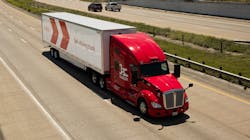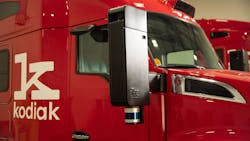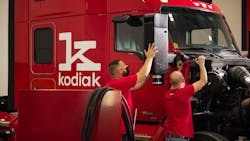Kodiak’s Gen4 self-driving truck sets 'Vision' on uptime, fleet expansion
Self-driving trucking company Kodiak Robotics plans to start running its fourth-generation autonomous truck later this year as it moves another step closer toward its goal of humanless long-haul freight transportation by 2023.
The next Kodiak self-driving Class 8 tractor combines lidar, radar, and camera technologies from its engineers and other industry partners into this “Gen4” truck. “For Kodiak, and for the self-driving industry, our Gen4 platform represents a giant step forward in delivering the performance, reliability, and serviceability requirements we need to launch our solution at scale to meet the needs of our customers and partners,” Jamie Hoffacker, Kodiak’s head of hardware, wrote in a Sept. 28 blog post about the new truck.
The Kodiak Gen4 truck will feature Luminar’s Iris lidar, ZF Full Range Radar, Hesai 360-degree scanning lidars for side- and rear-view detection, Cummins X15 Series engines, Bridgestone Americas smart-sensing tire technology, and the NVIDIA DRIVE platform. All of this will be built into Kenworth tractors.
Kodiak, which has been running freight in its self-driving trucks in Texas, expects to take delivery of 15 of the Gen4 vehicles by the end of the year, which would more than double its current fleet size. That current Kodiak fleet has been running freight along 240 miles of Interstate 45 between Dallas and Houston. Currently, there is a safety operator on board, but AI technology controls the tractor-trailer on the divided highway.
Kodiak, like many other autonomous trucking companies, has been operating in Texas. The company plans to extend its footprint across the southern U.S. “We think that we will be able to take the safety driver out of the cab and really deploy a true driverless solution in the market by 2023,” Don Burnette, co-founder and CEO of Kodiak Robotics, told FleetOwner earlier this year.
Kodiak Gen4’s pod system
Kodiak’s latest truck features a modular and discreet sensor suite—which it calls a “pod”—in three locations: a slim “center pod” on the front roofline of the truck and pods integrated into both of the side mirrors. The AI company said the "well-integrated and low-profile sensor placement simplifies sensor installation and maintenance" while increasing safety.
“Mirror pods are great locations for sensor mounting: they are low-vibration, and maximize rear-facing sightlines,” according to Hoffacker. “But they also offer numerous serviceability advantages. Kodiak’s mirror-pods are designed to be quickly and easily swapped out by repair technicians, without specialized training. This avoids us having to access the roof of the vehicle structure with ladders and specialized tools during a heatwave in Arizona or a hail storm in Texas.”
This pod system will allow Kodiak to increase uptime and scale-up production more quickly, according to CEO Burnette. “Complex and bulky systems that require an engineer to hand-build and hand-tune are expensive, unreliable, and difficult to debug,” he explained. “We believe that reliability and scalability flow from simplicity, and the best hardware modifications should be barely visible. Our fourth-generation platform is designed for simple, scaled production, which means easy calibration, troubleshooting, and maintenance for our partners.”
Kodiak Vision’s values
Kodiak’s perception system, Kodiak Vision, values the truck’s lidar, camera, and radar sensors the same. The AI system combines the information from the three sensors in each pod and considers each type’s relative strengths and weaknesses. Kodiak said this integrates extra redundancies and cross-validates data, adding another layer of safety to the self-driving system.
Kodiak’s new Gen4 truck will also improve Kodiak Vision’s performance and reliability with the help of the ZF Full Range Radar and Luminar’s long-range Iris lidar. These sensor integrations, combined with Kodiak’s integration with Hesai 360-degree scanning lidars, for side- and rear-view detection, provide automotive-grade reliability for long-haul trucks. All three sensors are built to meet the needs of autonomous trucks, which need to “see” long-range in a wide variety of weather conditions to safely operate at highway speeds, according to a Kodiak press release.
The ZF Full Range Radar provides four-dimensional (4D) capabilities, measuring the distance, height, lateral angle, and velocity of an object as much as 300-plus meters (984 ft.) down the road. This is different from traditional radar, which cannot measure the vertical position of an object.
“We are incredibly excited to make the ZF sensor our primary long-range radar for the Kodiak Driver,” Court Hinricher, a Kodiak hardware engineer, said. “We see this radar technology as critical to helping us bring self-driving trucks to market at scale. The addition of the ZF Full-Range Radar sensor allows our perception system to accurately track vehicle velocity at a range of up to 350 meters (1148 ft.), even in harsh weather conditions. And when integrated with additional sensors in our perception system, we can build a highly precise and expansive model of the world around our self-driving trucks.”
In another Sept. 28 blog post, Hinricher described the importance of 4D radar for the Kodiak system. “Traditional radar technology tracks objects in three dimensions, able to return an object’s horizontal position, distance, and velocity,” he wrote. “Note that an object’s vertical position is not on this list: traditional automotive radar has difficulty distinguishing overhead objects, such as road signs and bridges, from road hazards like stopped vehicles. In other words, traditional radar is almost like seeing the world from the top down.”
He noted that passenger cars equipped with automatic emergency braking (AEB) systems typically use bumber-mounted radars with a small vertical field of view that cannot detect overhead signs for 50 meters (164 ft.) in front of the car, which is typically the longest distance it takes a car to come to a complete stop when traveling the speed limit on a highway. But heavy-duty trucks need much more space to come to full stops.
“The ZF Full-Range Radar has the ability to measure that critical fourth dimension, an object’s vertical position, that a traditional radar cannot while maintaining its accuracy to a range of 300m or more,” Hinricher explained. “Traditional radars rely on a single Monolithic Microwave Integrated Circuit (MMIC), while in the ZF Full-Range Radar, four MMICs are cascaded, resulting in a total of 192 channels that provide highly accurate measurements of azimuth, elevation, range, and doppler. The long-range elevation (vertical position) measurement helps the Kodiak Driver resolve complex perception scenarios such as a stopped vehicle under a bridge, or a disabled vehicle on the shoulder under a road sign”.
Kodiak Vision also uses Luminar’s new automotive-grade Iris lidar’s wide horizontal and vertical field of view, enabling Kodiak trucks to recognize objects both near and far, adding further redundancy for long-range detections up to five 600 meters (1,969 ft.). The high resolution and range allow the system to reliably “see” objects such as pedestrians and motorcycles. The LiDAR’s slim design has a profile of 10 centimeters (3.9 in.), so it integrates into Kodiak Robotics’ discreet center roof pod in the front of the truck.
Kodiak Robotics’ patent-pending mirror pods—which will start with one Hesai lidar, two long-range 4D radars, and three cameras—don’t require specialized sensor calibration for easy upfit and repair. Rather than replacing a sensor in need of maintenance, a fleet technician can replace the entire mirror pod in a matter of minutes, the company stated. This single point of integration will allow maintenance and serviceability at scale.
Hardware + Software = NextGen AV
Kodiak has placed an order for 15 new Kenworth trucks that will be delivered over the next year. The trucks will more than double the company’s fleet size and help Kodiak expand its business delivering freight for commercial customers in Texas and beyond. Over the next couple of years, the company plans to expand throughout the southern half of the U.S. into other freight-rich corridors.
“Trucks are designed to operate for hundreds of thousands of miles and in the harshest of conditions; it should come as no surprise that self-driving trucks must also meet this same reliability bar,” Hoffacker said. “Over the last two years, we have driven hundreds of thousands of miles on constantly-changing highways day and night, rain or shine, in the Texas heat or in the cold. I can tell you from experience that this environment will quickly expose any design weaknesses in the Kodiak Driver’s hardware.
Under the hood, Kodiak’s fourth-generation trucks will be powered by Cummins X15 Series engines. These engines feature the Cummins ADS Powertrain interface, a control interface allowing the autonomous system to communicate with the engine. In addition, the 2021 X15 engines meet EPA and Greenhouse Gas Phase 2 requirements, providing a fuel economy improvement over previous generation engines and further enhancing the environmental benefits of Kodiak autonomous trucks.
Kodiak trucks run on Bridgestone tires and will be equipped with Bridgestone cloud-connected sensors that capture critical tire-centric data. Earlier this year, Bridgestone Americas made a minority investment in Kodiak. The two companies announced plans to integrate smart-sensing tire technologies into Kodiak’s fleet. According to both companies, that tire data will be analyzed and processed into live actionable insights, increasing uptime, improving overall safety, and enhancing the operational efficiency of Kodiak’s automated systems.
Kodiak’s new truck will also feature NVIDIA DRIVE Orin as the supercomputing platform, once available. With more than 250 TOPS (trillion operations per second) of computing performance, DRIVE Orin is architected for safety and addresses systematic safety standards such as ISO 26262 ASIL-D. In the interim, Kodiak will use the current generation NVIDIA DRIVE AGX Pegasus to process the data from the cameras, allowing the autonomous system to perceive the surrounding environment.
Once Kodiak adds the 15 Gen4 trucks to its Texas fleet, it plans to continue expanding to offer its technology as a service for other fleets. “In the long run, we plan to offer the Kodiak Driver to customers who want to integrate our technology into their own fleets,” according to Hoffacker. “Once we’ve deployed our trucks on partner fleets across the United States, we can’t depend on having specially-trained Kodiak engineers close-by in case a sensor component needs to be diagnosed, repaired, or recalibrated. Maintaining such a large fleet in such a large geography is more than a technology problem, it’s an operational problem.”
But with most of the AI-tech contained within the “custom-designed, mirror pods,” it should be easier for fleets to maintain the technology. “Building this kind of simplicity may seem, well, simple, but it’s not,” Hoffacker said. “It’s always easier to build something complex and clunky than something minimal. Gen4 didn’t come out of nowhere — it reflects everything we’ve learned over the last three-plus years of work preparing an autonomous truck for deployment.”
About the Author
Josh Fisher
Editor-in-Chief
Editor-in-Chief Josh Fisher has been with FleetOwner since 2017. He covers everything from modern fleet management to operational efficiency, artificial intelligence, autonomous trucking, alternative fuels and powertrains, regulations, and emerging transportation technology. Based in Maryland, he writes the Lane Shift Ahead column about the changing North American transportation landscape.



